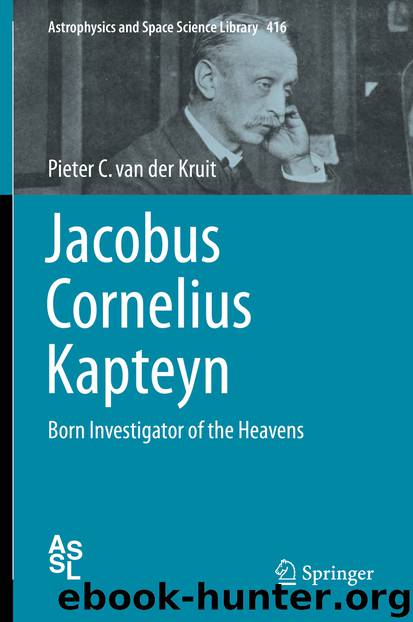Jacobus Cornelius Kapteyn by Pieter C. van der Kruit

Author:Pieter C. van der Kruit
Language: eng
Format: epub
Publisher: Springer International Publishing, Cham
The results are presented in a few tables. The first is a table which for stars out to a particular radius showed their number as a function of luminosity, the ‘luminosity function’. Then he derived the relative total density of stars in space, the relative number (for unity near the Sun) of stars per unit volume, as a function of parallax or distance. And finally he tabulated the fractional distribution of the absolute values for the total velocity of stars in space. This must have been impressive; he showed how we could find how stars were distributed in space and what the distributions of their luminosities and space velocities were.
He then discussed two more hypotheses that were necessary if progress was to be made. The first was the one stating that the distribution of stars as a function of their luminosity is the same everywhere. The second concerned the question of the extinction or absorption of starlight in space. This was timely, as George C. Comstock , who should have been present as he had chaired the previous session, had recently published a paper on proper motions of faint stars. I will come back to this later on in more detail, but what it comes down to is that Comstock repeated micrometer measures done by the von Struves at Pulkovo of positions of faint (about ninth magnitude) stars relative to nearby bright ones that in the meantime had well determined proper motions. Using Kapteyn’s determination of corresponding parallactic proper motions, he then found that these stars had rather high space velocities, if they conformed to Kapteyn’s extrapolated relations between mean parallax and proper motion and apparent magnitude. This meant in Kapteyn’s terms that ‘hypothesis A’ –‘ the fainter stars are of equal intrinsic luminosity with the brighter stars’– must be replaced by ‘its antithesis: The intrinsic luminosity of stars diminishes with their apparent brightness in such a ratio that a star of the tenth magnitude possesses only one-tenth of the luminosity of a star of the fifth magnitude’. Comstock postulated that this is due to an ‘absorbing medium’ producing considerable extinction of starlight. Kapteyn announced that he tended to disagree for the time being and would elsewhere present a method to test this. I will return to this in a later chapter.
Kapteyn also refrained from further discussions and turned to the question of the fundamental hypothesis that there was in space no preferred direction in the motions of the stars. For this he pointed to a figure that he actually presented earlier on in his lecture and which is reproduced in Fig. 9.12. In part P he illustrated the fundamental hypothesis. On average, proper motions were equal in size and distributed evenly over all possible directions. But we observe them from a vantage point moving through space with the Sun, which will modify the distribution as in Q; the distribution of proper motions would be drawn out in the direction of the Solar Antapex, the horizontal line labeled x. ‘Near to
Download
This site does not store any files on its server. We only index and link to content provided by other sites. Please contact the content providers to delete copyright contents if any and email us, we'll remove relevant links or contents immediately.
Tools of Titans by Timothy Ferriss(7813)
Turbulence by E. J. Noyes(7700)
Astrophysics for People in a Hurry by Neil DeGrasse Tyson(5000)
Secrets of Antigravity Propulsion: Tesla, UFOs, and Classified Aerospace Technology by Ph.D. Paul A. Laviolette(4992)
Design of Trajectory Optimization Approach for Space Maneuver Vehicle Skip Entry Problems by Runqi Chai & Al Savvaris & Antonios Tsourdos & Senchun Chai(4840)
Room 212 by Kate Stewart(4736)
Pale Blue Dot by Carl Sagan(4613)
The David Icke Guide to the Global Conspiracy (and how to end it) by David Icke(4380)
A Journey Through Divination and Astronomy by Publishing Pottermore(4249)
Apollo 8 by Jeffrey Kluger(3512)
Goodbye Paradise(3446)
Losing the Nobel Prize by Brian Keating(3425)
COSMOS by Carl Sagan(3347)
The Five People You Meet in Heaven by Mitch Albom(3334)
How to Read Water: Clues and Patterns from Puddles to the Sea (Natural Navigation) by Tristan Gooley(3240)
Brief Answers to the Big Questions by Stephen Hawking(3239)
How to Read Nature by Tristan Gooley(3078)
The Order of Time by Carlo Rovelli(3073)
A Brief History of Time by Stephen Hawking(2819)
